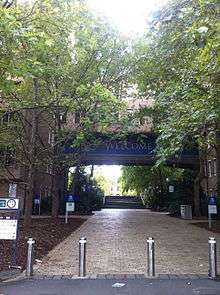John Medley Building
The John Medley Building is at Kernot Road, Melbourne University, Parkville Campus, Melbourne, Australia. The building was designed by Sir Roy Burman Grounds (18 December 1905 – 7 March 1981). It was constructed between 1969 and 1971,[1] and was built to relieve the cramped conditions of the campus Old Arts Building, which was built from 1919 to 1924, and to house the larger departments of the university’s faculty office.[2]

According to Sowerwine & Gamer, 2007, many in the university community began to demand more attention be paid to architectural issues of the campus; for that reason, Grounds was appointed as architect of the John Medley Building.[2] Grounds, who developed an interest in the Bauhaus and architectural modernism, was a leader of the modernist movement who had broken away from its principles. The John Medley Building disappointed many, notwithstanding that Grounds was seen as prolific in the profession following his design of the Victorian Arts Centre.[2]
Design
The John Medley Building sits as a giant gateway to the Parkville campus of Melbourne University. It flanks the original axis of the campus’s clock tower from Grattan Street, which leads to the Old Quadrangle. The building is one of the few places on campus where a sense of ceremony is created.[1]
The building includes two medieval tower-like buildings that are joined by an arched walkway, and the pronounced corners of the building’s towers suggest a fortress city. The fifth-floor Common Room, which bridges the two towers, provides excellent views of the City and the University.[2] The two six storey towers are named ‘East Tower’ and ‘West Tower’, and are capped by the sixth story’s projected eaves. The windows of the lower levels are fitted with rounded framed, aluminum sash windows, whereas the equidistant windows of each tower’s upper level appear castellated. Some windows of the towers are fitted with hooded shades.
It is not clear what materials were used to construct the John Medley Building. The building appears, from observation, to have been predominantly constructed from a light-brown brick. The pronounced corners of the towers appear to be formed using pre-cast concrete. The bridge section marks the John Medley Building in the Brutalist style, which reflected similar designs on college campuses in the United States and Canada in the previous decade. Consistent with that style, the bridge section has an inset first level of exposed aggregate concrete with thin arrow-slit windows.
The John Medley Building in Grounds’ body of work
Grounds’ initial design layout of the John Medley Building in 1967 drew criticism for not being functionalist enough, for having too much unusable space, and for not enough unusable space.[1] While the building possesses modernist, especially Brutalist, tones of Grounds’ earlier National Gallery of Victoria (constructed 1959-1968), the building also reflects Grounds’ interest in the Italian Neo-Liberty movement.[3] This may be seen through what Hamann, 2007 describes as, the hybridisation of palazzo forms and medieval references, which was seen by some critics as a betrayal of modernism; to combine such historical details.[3] It was an articulation of Grounds style however, that was already evident in previous examples, such as the design Grounds prepared for Melbourne's National Art Gallery, which, according to Hamann, 2007, has an ‘oriental styled palazzo’ type of planning, and in the Cultural Centre of the late 1950s.[3]
References
- 1 2 3 Goad, P, and Tibbits, G 2003, Architecture on Campus. A Guide to the Architecture of the University of Melbourne and its Colleges, MUP, Carlton , page 80
- 1 2 3 4 Sowerwine, C, and Gamer, A 2007, The Wandering Scholar’s Guide to Melbourne, The University of Melbourne, page 12, http://www.unimelb.edu.au/publications/docs/WanderingScholarBooklet.pdf, accessed 29 April 2013.
- 1 2 3 Hamann, C 2007, Grounds, Sir Roy Burman (1905–1981), Australian Dictionary of Biography, National Centre of Biography, Australian National University, http://adb.anu.edu.au/biography/grounds-sir-roy-burman-12571/text22635, accessed 29 April 2013